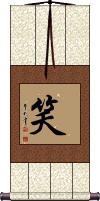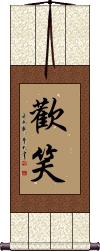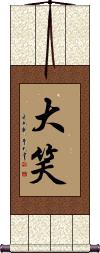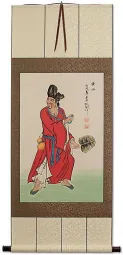Many custom options...
And formats...

Not what you want?
Try other similar-meaning words, fewer words, or just one word.
The name Laugh Smile in Chinese / Japanese...
Buy a Laugh Smile calligraphy wall scroll here!
Personalize your custom “Laugh Smile” project by clicking the button next to your favorite “Laugh Smile” title below...
Laugh / Smile
笑 simply means to laugh or smile.
Notes: In some contexts, it can mean “ridicule” in Korean Hanja. 笑 is not often seen alone in Japanese, though it is understood.
Live Laugh Love
In English, the word order shown in the title is the most natural or popular. In Chinese, the natural order is a little different:
The first character means laugh (sometimes means smile).
The second character means love.
The last two characters mean “live” as in “to be alive” or “pursue life.”
Please note: 笑愛生活 is not a normal phrase in that it does not have a subject, verb, or object. It is a word list. Word lists are not common in Asian languages/grammar (at least not as normal as in English). We only added this entry because so many people requested it.
We put the characters in the order shown above, as it almost makes a single word with the meaning “A life of laughter and love.” It's a made-up word, but it sounds good in Chinese.
We removed the Japanese pronunciation guide from this entry, as the professional Japanese translator deemed it "near nonsense" from a Japanese perspective. Choose this only if your audience is Chinese and you want the fewest-possible characters to express this idea.
In Korean, this would be 소애생활 or "so ae saeng hwar" but I have not confirmed that this makes sense in Korean.
Happy Laughter
Roar of Laughter / Big Laughs
大笑 can be translated as “roar of laughter,” “loud laughter,” “hearty laugh,” or “cachinnation.”
The first character means big or great, and the second means to laugh or smile.
If you like humor, this is a great wall scroll to hang in your home.
See Also: The Whole Room Rocks With Laughter
This in-stock artwork might be what you are looking for, and ships right away...
Not the results for Laugh Smile that you were looking for?
Below are some entries from our dictionary that may match your Laugh Smile search...
| Characters If shown, 2nd row is Simp. Chinese |
Pronunciation Romanization |
Simple Dictionary Definition |
笑 see styles |
xiào xiao4 hsiao warau わらう |
More info & calligraphy: Laugh / Smile(abbreviation) (slang) LOL; haha; (female given name) Warau to laugh |
一笑 see styles |
isshou / issho いっしょう |
(noun/participle) laugh; smile; (female given name) Hitoe |
乾笑 干笑 see styles |
gān xiào gan1 xiao4 kan hsiao |
to give a hollow laugh; to force a smile; forced laugh; CL:聲|声[sheng1] |
冷笑 see styles |
lěng xiào leng3 xiao4 leng hsiao reishou / resho れいしょう |
to sneer; to laugh grimly; grin of dissatisfaction (bitterness, helplessness, indignation etc); bitter, grim, sarcastic or angry smile (noun, transitive verb) sneer; derision; scornful laugh; cold smile |
咲い see styles |
warai わらい |
(1) laugh; laughter; (2) smile; (3) sneer; (4) sex aids (e.g. dildos, pornographic books, erotic woodblock prints, etc.) |
咲う see styles |
warau わらう |
(v5u,vi) (1) to laugh; (2) to smile; (3) to sneer; to ridicule; (4) to be dumbfounded; to be flabbergasted |
嗤い see styles |
warai わらい |
(1) laugh; laughter; (2) smile; (3) sneer; (4) sex aids (e.g. dildos, pornographic books, erotic woodblock prints, etc.) |
嗤う see styles |
warau わらう |
(v5u,vi) (1) to laugh; (2) to smile; (3) to sneer; to ridicule; (4) to be dumbfounded; to be flabbergasted |
笑い see styles |
warai わらい |
(1) laugh; laughter; (2) smile; (3) sneer; (4) sex aids (e.g. dildos, pornographic books, erotic woodblock prints, etc.) |
笑う see styles |
warau わらう |
(v5u,vi) (1) to laugh; (2) to smile; (3) to sneer; to ridicule; (4) to be dumbfounded; to be flabbergasted |
苦笑 see styles |
kǔ xiào ku3 xiao4 k`u hsiao ku hsiao kushou / kusho くしょう |
to force a smile; a bitter laugh (n,vs,vi) bitter smile; wry smile; strained laugh; sarcastic laugh |
解頤 解颐 see styles |
jiě yí jie3 yi2 chieh i |
to smile; to laugh |
冷笑い see styles |
seserawarai せせらわらい |
sardonic laugh; scornful smile |
嘲笑い see styles |
seserawarai せせらわらい |
sardonic laugh; scornful smile |
嘲笑う see styles |
seserawarau せせらわらう azawarau あざわらう |
(out-dated kanji) (transitive verb) to laugh mockingly; to smile with contempt; to scorn; (transitive verb) to sneer at; to ridicule |
法令紋 法令纹 see styles |
fǎ lìng wén fa3 ling4 wen2 fa ling wen |
nasolabial fold; smile lines; laugh lines |
法令線 see styles |
houreisen / horesen ほうれいせん |
nasolabial fold; smile lines; laugh lines |
笑える see styles |
waraeru わらえる |
(v1,vi) (1) to laugh; to break into laughter; to be made to laugh; (v1,vi) (2) to be funny; to be laughable; to make one laugh; to make one smile |
苦笑い see styles |
nigawarai にがわらい |
(n,vs,vi) bitter smile; wry smile; forced smile; strained laugh |
豊麗線 see styles |
houreisen / horesen ほうれいせん |
nasolabial fold; smile lines; laugh lines |
豊齢線 see styles |
houreisen / horesen ほうれいせん |
nasolabial fold; smile lines; laugh lines |
鼻唇溝 鼻唇沟 see styles |
bí chún gōu bi2 chun2 gou1 pi ch`un kou pi chun kou bishinkou / bishinko びしんこう |
nasolabial fold; smile lines; laugh lines nasolabial sulcus; nasolabial groove; nasolabial fold |
作り笑い see styles |
tsukuriwarai つくりわらい |
(noun/participle) forced laugh; forced smile |
含み笑い see styles |
fukumiwarai ふくみわらい |
(noun/participle) suppressed laugh; smile; giggle; chuckle |
嘲ら笑う see styles |
seserawarau せせらわらう |
(out-dated kanji) (transitive verb) to laugh mockingly; to smile with contempt; to scorn |
愛嬌笑い see styles |
aikyouwarai / aikyowarai あいきょうわらい |
(rare) (See 愛想笑い) insincere laugh; insincere smile; ingratiating smile |
照れ笑い see styles |
terewarai てれわらい |
(n,vs,vi) embarrassed smile; embarrassed laugh; bashful smile |
追従笑い see styles |
tsuishouwarai / tsuishowarai ついしょうわらい |
servile smile; sycophantic smile; servile laugh; sycophantic laugh |
せせら笑い see styles |
seserawarai せせらわらい |
sardonic laugh; scornful smile |
せせら笑う see styles |
seserawarau せせらわらう |
(transitive verb) to laugh mockingly; to smile with contempt; to scorn |
Click here for more Laugh Smile results from our dictionary
The following table may be helpful for those studying Chinese or Japanese...
| Title | Characters | Romaji (Romanized Japanese) | Various forms of Romanized Chinese | |
| Laugh Smile | 笑 | e / shou / wa e / sho / wa | xiào / xiao4 / xiao | hsiao |
| Live Laugh Love | 笑愛生活 笑爱生活 | xiào ài shēng huó xiao4 ai4 sheng1 huo2 xiao ai sheng huo xiaoaishenghuo | hsiao ai sheng huo hsiaoaishenghuo |
|
| Happy Laughter | 歡笑 欢笑 | huān xiào huan1 xiao4 huan xiao huanxiao | huan hsiao huanhsiao |
|
| Roar of Laughter Big Laughs | 大笑 | taishou / taisho | dà xiào / da4 xiao4 / da xiao / daxiao | ta hsiao / tahsiao |
| In some entries above you will see that characters have different versions above and below a line. In these cases, the characters above the line are Traditional Chinese, while the ones below are Simplified Chinese. | ||||
Successful Chinese Character and Japanese Kanji calligraphy searches within the last few hours...








